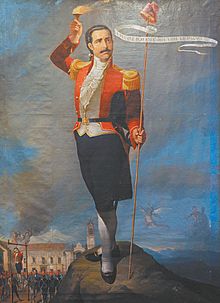La Paz revolution facts for kids

Pedro Murillo, leader of the revolution.
|
|
| Date | July 16, 1809 |
|---|---|
| Location | La Paz, Upper Peru (modern Bolivia) |
| Participants | Criollos from La Paz |
| Outcome | Temporary removal of Spanish authorities and declaration of independence. Spanish rule restored by Goyeneche |
In 1809, the city of La Paz, located in a region then called Upper Peru (which is now Bolivia), had a big change. People there started a revolution against the Spanish rulers. They wanted to be independent.
This event is seen as an important early step in the Spanish American wars of independence. It helped lead to the later independence of Bolivia. However, the revolution in La Paz did not last long. Spanish rule was soon brought back to the city.
Why the Revolution Started
In 1781, a group of Aymara people surrounded La Paz for six months. Their leader was Túpac Katari. They destroyed churches and government buildings. Even though this effort by the native people failed, the idea of independence kept growing. Spanish and Creole soldiers stopped their fight.
About 30 years later, native people again surrounded La Paz. This time it lasted two months. This is when the famous story of the Ekeko is said to have happened.
The chance for independence came back in 1807. This was when Napoleon's French troops moved through Spain. Spain's power was getting weaker. The United States had become independent in 1776. This inspired many people in the Americas. They saw that colonists could remove foreign rulers.
Spain's government was falling apart. King Charles IV gave up his throne. Then his son Ferdinand VII became king. But he also gave up the throne to Joseph Bonaparte, Napoleon's brother. This made Spain very unstable. It was a perfect time for a revolution.
How the Revolution Happened
On July 16, 1809, people in La Paz were celebrating the Virgin of Carmen. A group of revolutionaries took action. Their leader was Colonel Pedro Domingo Murillo. They surrounded the city's army barracks. They forced the governor, Tadeo Davila, to resign. The Bishop of La Paz, Remigio de la Santa y Ortega, also had to step down.
On that day, Pedro Domingo Murillo, who was of mixed heritage, made a famous statement. He said the Bolivian revolution was like lighting a lamp. He believed no one would be able to put it out. Many historians agree that this moment began the fight to free South America from Spain.
Local leaders, called the cabildo, took control first. Then, a special group was formed. It was called the "Junta Tuitiva de los Derechos del Pueblo". This means "Junta, keeper of the rights of the people". Murillo was its head. On July 27, this Junta officially declared that the colony was independent.
José Manuel de Goyeneche was asked to lead the Spanish royalist forces. These were troops loyal to the Spanish king. They were sent to stop the rebels. Many revolutionaries joined Murillo's army. They marched to Chacaltaya to wait for the enemy. But a counter-revolution started in La Paz itself. This was led by Pedro Indaburo.
Murillo defended La Paz with about 800 soldiers. Viceroy José Fernando de Abascal sent troops from Lima to stop the revolt. A Viceroy was like a governor for a large area. He also used this chance to make Upper Peru part of his area, Peru, again. Most people in Peru were loyal to the Spanish king. This was true even for many Americans living there. Rich people in Lima hoped to gain rewards by staying loyal to the King.
Murillo and the other leaders of the revolution were captured. They were later executed.
See also
 In Spanish: Junta Tuitiva para niños
In Spanish: Junta Tuitiva para niños
- Bolivian War of Independence
- Chuquisaca Revolution
- May Revolution
- History of Bolivia

